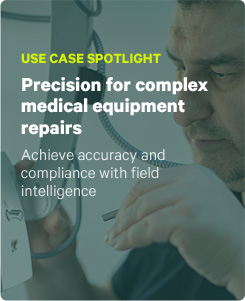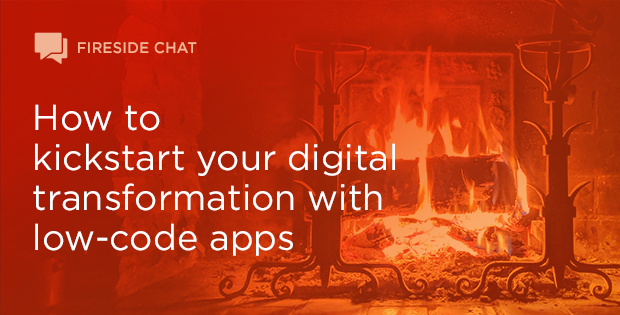It’s getting colder and there’s no better way to cozy up than with a fireside chat! In the first of two fireside chats, ProntoForms’ (now TrueContext’s) Product Management VP Russ Halliday and Product Marketing Manager Joel Fear discuss the impact of low-code application platforms (LCAP) in fieldwork. So load up on smores and prepare to learn how LCAPs are shaping field processes and digital transformation.
What wider demand do you believe LCAP is satisfying?
JOEL: What you’re seeing now are customers who demand a much higher level of service engagement than ever before. This, in turn, places demands on field service organizations to deliver exceptional, seamless digital experiences.
Secondly, IT teams and business leaders are being asked to do more with less and to optimize with the resources and people they already have. This pressure means that new approaches to building software, specifically low code tools, need to be investigated. These tools primarily help people without coding skills — also known as citizen developers — lead traditionally IT-led software development projects. This hand-off of solution building is key. Citizen developers can rapidly build and deploy prototypes and proof of concepts through an LCAP that are controlled within the bounds that IT sets. These rapid design iterations enable organizational agility on a whole new level, resulting in dramatic cost-saving in IT projects.
In regard to customer service, connecting CRMs, ERPs, and supply chain data into every single field engagement brings this data together. It enables operational visibility for higher first-time fix rates, and improved customer interactions, which all contributes to delivering world-class customer service.
How does an LCAP differ from mobile forms? Is there a difference?
JOEL: There’s definitely a difference. LCAPs are meant to deliver a broader solution beyond the creation of mobile forms. For example, consider the main parts of a field service workflow: job dispatch, execution of the job itself, and then submission of completed work back to the office. These are all important parts of overall business processes and, combined, model the most complex and difficult operational aspects of field service. That’s the piece that mobile forms miss. There are plenty of fillable forms on mobile devices out in the market, but the key to unlocking value doesn’t end with the form itself.
The most common scenarios we see of “going beyond” the mobile form are illustrated in this example:
- Once they built the form, they needed to pre-populate that document with back-office data, such as the customer address and job information, instead of the worker filling it manually.
- Next, they needed to dispatch that form to a specific field worker, or group of workers, and track their progress.
- Once the worker received the dispatch there was the question of what on-device capabilities the worker could leverage to accomplish their work faster or more accurately — like captured photos or scanned barcodes.
- Finally, after the document was sent back to the office, what capabilities were needed to provide traceability and to escalate if things didn’t go well?
A field-focused LCAP provides the complete solution out-of-the-box for all the examples above. As an application platform, the technology is optimized not just to provide a powerful mobile form, but also to meet the specific challenges that field service environments face on a daily basis. A stand-alone mobile form cannot achieve all this by itself.
So, in summary, the difference between mobile forms and LCAPs is significant. Mobile forms are just one part of a much larger solution. Without an application platform to back it, much of the value of a mobile form is lost.
How many paper forms can an LCAP replace in an SME or large enterprise?
RUSS: All of them. And it can be done very quickly. Some forms can be converted in minutes. We have customers who have one form and we have customers who have hundreds of forms—the number of replaced forms are as broad as your imagination.
We have yet to come against a paper form that can’t be translated to digital. In fact, digital technologies give you access to far richer content then you’ll ever get out of paper — whether it’s photos or mixed media.
Let’s say you have paperwork as part of your process. Typically, your field technicians do the work and then fill in the corresponding paperwork. Wouldn’t it be better if, as a byproduct of the work they’re already doing, the paperwork is created for your technicians — logged, compliant, accurate, and consistent? That’s the promise that we can start to deliver through an LCAP solution. There’s really no comparison.
After all, the core job that technicians have when they’re in the field isn’t the paperwork. That’s something they have to do for business and compliance reasons. Their main job is to make something physical in the real-world work better or to understand what’s happening with it so they can make sure it continues to work well. The recording of that shouldn’t be something technicians have to spend extra time trying to do.
Any advice for those starting digital transformation journey and looking to go mobile by ditching paper?
RUSS: Do your homework before you buy and regret. It’s worth pausing to think ahead a bit to where you expect to land, even if you don’t plan to get there in a single step. It really comes down to what problem you’re trying to solve:
- Is your goal to remove paper and get rid of errors in paper processes?
- Is it to start moving down a path towards integrating your field workflows into your back office?
- Is it to create a means for harvesting better data from the frontlines and integrate that into business data for better business insights?
If it’s the first problem, there are tools out there that can help you solve that problem. If you’re looking at a more aggressive approach that puts you on a trajectory further down that digital transformation journey, there are far fewer players that can stand with you through that whole trip.
Why is field-focused differentiation critical when considering an LCAP solution for field teams?
JOEL: Building software to enable field-focused organizations is a very significant challenge given the high complexity of the operating environments and range of issues workers solve during any given job. Thinking about some of the core problems our customers ask us to help them solve — such as worker mobility, connecting back-office data closer to the field, and operational visibility — these are problems that general-purpose LCAP solutions require IT departments and citizen developers to spend time, money, and effort on.
For field service, if your LCAP is highly generalized, many field service workflows are missing from the outset and have to be built and maintained from the ground up. And that’s if they’re even built at all. A lot of people will just skip over a problem and try to work around it.
A lot of these general-purpose platforms come in and claim: “you can build anything.” But there’s not really a productivity advantage. You’re not really gaining faster time to value. All you’re doing is raising the level of obstruction and hoping you have enough people to get all these applications built, with the industry knowledge needed to make it useful.
So if considerations such as time to value, workforce adoption, and ease of development are part of your decision-making process, just remember that a field-focused, best-of-breed solution provides real advantages and reduces risk when investing in an LCAP solution for a field team.
Conclusion
In our next fireside chat, we’ll crank up the heat. It’s one thing to understand how LCAP works in the field but it’s another to chart where field service is headed and to be prepared for these changes. Don’t miss it or else you might be caught three years down the line without a field service “fire extinguisher”.




